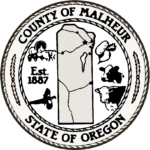A septic system is the most common method of sewage treatment for homes that are not on a public sewer line. A septic system consists of a septic tank, where solids settle and decompose, and a drain field where liquid discharged from the tank is treated by bacteria living in the soil. The septic tank settles out and decomposes solid sewage. The resulting liquid discharge from the tank slowly seeps into the drain field where it receives final treatment from bacteria living in the soil. Properly functioning septic systems treat sewage to prevent ground and surface water pollution. A malfunctioning system is a health hazard to your family and your neighbors, and will harm natural resources.
Before you buy
Before you buy undeveloped property, ask if the property has been evaluated for a septic system. If not, have Malheur County Environmental Health evaluate it for a septic system before purchase.
When checking an existing septic system in a home you might want to buy, Environmental Health advises that you hire a qualified inspector to check out the system. Here are the main things to investigate:
Is the system legal?
Was it installed with a permit?
Is the system the proper size to accommodate the needs of your family or business?
How old is the system and has it been properly maintained?
When was the septic tank last pumped?
Have there been any problems in the past?
Are all plumbing fixtures connected to the septic tank?
How many people previously lived in the house?
Are there signs of septic system failure such as soggy areas over the septic tank or drain field areas?
Installing a new system
Getting a new septic system installed is a two step process. The first step is to apply for a site evaluation. A septic system specialist will evaluate your property and identify the type of septic system needed and the best location for it. The second step is to apply for a septic system construction permit. Contact Malheur County Environmental Health for application forms or download application forms from this web site. There is a fee for a site evaluation as well as for the permit.
Maintaining septic systems
You can avoid costly repairs by having your septic tank inspected on a regular basis for solids accumulation. When the solids accumulation is greater than 40 percent, have your septic tank pumped by a DEQ-licensed pumper. A properly constructed and maintained system can last a long time if you follow some common Septic System DO’s and DON’Ts:
|
DON’T flush material that will not easily
decompose, such as hair, diapers, cigarette butts, matches, or feminine hygiene products. |
DO conserve water to avoid overloading the
system. |
|
DON’T wash or flush medicines or hazardous
chemicals like paint, paint thinner and bleach into the system. They kill the bacteria needed to decompose wastes in the septic tank and drain field. |
DO use substitutes for household hazardous
waste. |
|
DON’T drive over the septic tank or drain
lines. |
DO learn the location of your septic tank
and drain field. Keep a sketch of it handy with your maintenance record for service visits. |
|
DON’T plant anything over or near the drain
field except grass. Roots from nearby trees or shrubs may clog and damage drain lines. |
DO cover the drain field with a grass cover
to prevent erosion and remove excess water. |
|
DON’T dig in your drain field or build anything
over it. |
DO keep your septic tank cover accessible for inspections and pumping. Install risers if necessary.
|
|
DON’T cover the drain field with a hard surface
such as concrete or asphalt. |
DO keep a detailed record of repairs, pumping, inspections, permits issued, and other maintenance activities.
|
|
DON’T make or allow repairs to your septic system without obtaining the required permit. Use professionally licensed septic contractors when needed.
|
DO divert other sources of water, like roof
drains, house footing drains, and sump pumps, away from the septic system. Excessive water keeps the soil in the drain field from naturally cleansing the wastewater. |
|
DON’T use septic tank additives. These products
usually do not help and some may even be harmful to your system. |
DO have your septic tank pumped out
regularly by a DEQ licensed contractor. |
|
DON’T allow backwash from home water softeners
to enter the septic system. |
DO call a professional whenever you
experience problems with your system, or if there are any signs of system failure. |
|
DON’T enter your tank, any work to the tank
should be done from outside. Gases that can be generated in the tank and/or oxygen depletion can be fatal. |
Signs of septic system failure
Pools of water or soggy spots, foul odors, and/or dark gray or black soils in the area of your drain field. Water that surfaces over the drain field during heavy rain or when doing laundry. Sewage backs up into the lowest drains in the house. Gurgling of drains, slow drainage (check for clogs first). Soggy soil overlying the drain field.
